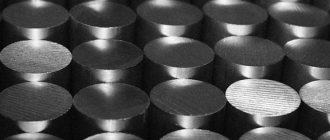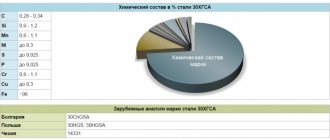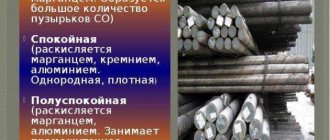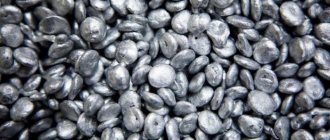Structural carbon or high-carbon steel includes spring steel. To give it highly targeted properties, it is doped in small quantities with 2-3 elements, for a total of up to 2.5%. But the use of these steel grades is not limited to the manufacture of springs. This group is called that because the name most strongly reflects their main feature - elasticity.
Characteristics of spring steels
Spring steels are characterized by increased yield strength (δB) and elasticity. This is the most important characteristic of metal - to withstand mechanical loads without changing its original shape. Those. a metal subjected to tension or, conversely, compression (elastic deformation), after removing the acting forces from it, must remain in its original shape (without residual deformation).
Types and scope of spring steel
Based on the presence of additional properties, spring steel is divided into alloy (stainless) and carbon. Alloy steel is based on carbon steel with a C content of 65-85% and is alloyed with 4 main elements, all or selectively, each of which brings its own characteristics:
- chromium;
- manganese;
- silicon;
- tungsten.
Chromium - at a concentration of more than 13%, works to ensure the corrosion resistance of the metal. With a chromium concentration of about 30%, the product can work in aggressive environments: acidic (except sulfuric acid), alkaline, aqueous. Corrosion spring steel is always alloyed with a second accompanying element - tungsten and/or manganese. Operating temperature up to 250 °C.
Tungsten is a refractory substance. When its powder gets into the melt, it forms numerous crystallization centers, crushing the grain, which leads to increased plasticity without loss of strength. This brings its advantages: the quality of such a structure remains very high during heating and intense abrasion of the surface. During heat treatment, this element retains its fine-grained structure and eliminates softening of steel during heating (during operation) and dislocation. During hardening, it increases hardenability, as a result of which the structure becomes homogeneous to a greater depth, which in turn increases the service life of the product.
Manganese and silicon usually participate in mutual doping, and the ratio always increases in favor of manganese, up to about 1.5 times. That is, if the silicon content is 1%, then manganese is added in an amount of 1.1-1.5%.
Refractory silicon is a non-carbide-forming element. When it enters the melt, it is one of the first to take part in crystallization, pushing carbon carbides to the grain boundaries, which accordingly leads to strengthening of the metal.
Manganese can be called a structure stabilizer. By simultaneously distorting the metal lattice and strengthening it, manganese eliminates the excessive strength of silicon.
In some steel grades (when the product is operating in high-temperature conditions, at temperatures above 300 ºC), nickel is added to the steel. It eliminates the formation of chromium carbides along grain boundaries, which lead to matrix destruction.
Vanadium can also be an alloying element, its function is similar to that of tungsten.
Spring brands specify the element copper; its content should not exceed 0.15%. Since copper, being a low-melting substance, concentrates at the grain boundaries, reducing strength.
Spring brands include: 50HG, 3K-7, 65G, 65GA, 50HGFA, 50HFA, 51HFA, 50HSA, 55S2, 55S2A, 55S2GF, 55HGR, 60G, 60S2, 60S2A, 605, 70, 70G, 75, 80, 85, 60С2ХА , 60S2HFA, 65S2VA, 68A, 68GA, 70G2, 70S2XA, 70S3A, 70HGFA, SH, SL, SM, DM, DN, KT-2.
Grades of such steel are used for the manufacture of not only springs and leaf springs, although this is their main purpose, which characterizes the main property. They are used wherever there is a need to provide the product with elasticity, ductility and strength at the same time. All parts made from these grades are subject to tension and compression. Many of them experience loads that periodically replace each other, and with a huge cyclic frequency. This:
- bearing housings that experience compression and tension at each point with high frequency;
- friction discs experiencing dynamic loads and compression;
- thrust washers, most of the time they experience compression loads, but a sharp change in tension can also be added to them;
- brake bands, for which one of the main tasks is elasticity under repeated stretching. With this dynamic of increased aging and wear, stronger steel (with less elasticity) is susceptible to rapid aging and sudden failure.
The same applies to gears, flanges, washers, collets, etc.
Spring steel 65G
Iron combines with carbon to form steel. The proportions of these chemical elements may vary depending on the application and required properties. To achieve good strength and the required durability, components are added to alloys that are needed to improve the properties of the metal.
Many gunsmiths set themselves the task of creating high-strength steel for a knife, while at the same time hardness should not suffer. 65G steel is popular these days.
Characteristics
Low cost has made 65g steel quite popular. But due to its poor corrosion resistance, the material is almost never used for making kitchen knives. When hardened, the alloy is not afraid of overheating. But at high temperatures, impact strength decreases. The hardening temperature ranges from 800 to 8200 C.
pros
The main advantage is the low cost of the product. It was this factor that made the brand quite popular. In addition to this advantage, there are the following advantages:
- Impact and deformation resistance.
- Increased hardness, preventing destruction, brittleness or brittleness under heavy loads.
- Ease and speed of sharpening.
- High tensile strength.
Marking
Spring-spring steels can be grouped by position:
- unalloyed with a carbon content of 65-85% - inexpensive general purpose steel;
- manganese-silicon - the cheapest with high physical and chemical properties;
- chrome-manganese - stainless steel, works in aggressive environments at t -250 +250 C;
- additionally alloyed and/or tungsten, vanadium, boron - they are steels with an increased service life due to their homogeneous structure, an excellent strength-to-ductility ratio due to fine grains and can withstand high mechanical loads. They are used on such objects as railway transport.
Marking of spring steels is carried out as follows. Let's look at the example of 60S2HFA:
- 60 - percentage of carbon in tenths (carbon is not indicated in a letter value);
- C2 - letter designation of silicon with index 2, indicates a 2-fold increase in the standard content (1-1.5%);
- X - presence of chromium up to 0.9-1%;
- F - tungsten content up to 1%;
- A - the added letter index A at the end of the marking indicates the minimum content of harmful impurities of phosphorus and sulfur, no more than 0.015%.
Types and applications
From the name it follows that the scope of use of these materials is limited to the production of springs, leaf springs, knives and other engineering products, which require an optimal combination of strength and elastic properties. However, there are other, more exotic applications for this type of metal.
Spring steels have long been used to make music wire, most commonly found in pianos. Musicians use spring steel in pianos because the piano string needs to be very tightly tensioned, and in this condition it must withstand the constant blows of the hammers of the keys.
Spring steel is also used to make guitar strings.
The armor and swords of actors who star in popular medieval films or TV series are also made from spring steel. They must be light enough to allow the actor to move freely while maintaining the authenticity of the image he is creating. After all, it is much easier to swing a sword made of spring steel than a weapon that is forged from iron or other heavy metals. The best part is that the armor and weapons that you see on the big screen are completely identical to those worn by the winners of knightly tournaments or the usual hand-to-hand combat of those days.
Production
Depending on further processing and the final type of part, steel is supplied in sheets, wire, hexagons, and squares. High performance qualities of the product are ensured by 2 components:
- the structure of the metal, which is determined by the chemical composition and subsequent processing;
- the presence of non-metallic inclusions in the structure, or rather the minimum quantity and size, which is eliminated at the stage of smelting and casting;
- the shape of the part (spiral, arc) and its dimensions, which is determined by the calculation method.
When the spring is stretched, the inner and outer sides of the coils experience different degrees of stress: the outer ones are less susceptible to stretching, while the inner ones experience the greatest degree of deformation. The same applies to the ends of the spring: they serve as attachment points, which increases the load in these and adjacent places. Therefore, steel grades have been developed that are preferably used for compression or tension.
Spring steel grades used in industry
Spring steel, grades of which are applicable in the manufacture of tight products, characterized by restoration of the original shape, with strong bending and significant twisting.
The most important parts in the production of mechanisms that experience variable, repeated loads, under the influence of which severe deformation occurs. As soon as the load stops, these elements return to their original shape. There is a feature in the operation of these parts that does not allow residual destruction; it must only be elastic. Excessive production requirements are placed on spring steels. Let's figure out what kind of steel springs are made of?
Thermo-mechanical treatment
Without exception, all spring steels are subjected to thermomechanical treatment. After it, strength and wear resistance can increase 2 times. The product is shaped in an annealed state, when the steel has the maximum possible softness, after which it is heated to 830-870 C and cooled in an oil or water environment (only for grade 60 CA). The resulting martensite is tempered at a temperature of 480 ºC.
All requirements and recommendations for this type are described in GOST 14959-79. Based on them, the company develops more detailed technological sheets that meet narrow parameters.
Rate this article:
Rating: 5/5 — 1 votes
Steel grades according to GOST 14959–79
These are steels with a high carbon content, but with low alloying. Gosstandart 14959 means alloyed alloy of the following grades:
- 3K-7 - used in the production of cold-drawn wire, from which non-hardening springs are made;
- 50ХГ – produce springs for cars and springs for railways. compositions;
- 50HGA - purpose in production as in the previous brand of spring steel;
- 50HGFA – produce special springs and spring parts for cars;
- 50ХСА – special-purpose springs and small parts for watch mechanisms;
- 50HFA - they produce parts with increased load, with the requirements of the highest stability and strength, which operate at high temperatures - up to 300 degrees.
- 51HFA – for spring wire;
- 55С2 - for the production of spring mechanisms and springs used in tractor construction, mechanical engineering, for railway rolling stock;
- 55С2А – produces auto springs, springs for trains;
- 55S2GF - for the production of very strong springs of a special type, autosprings;
- 55KhGR – produce spring strip steel, the thickness of which varies from 3 to 24 mm;
- 60G - for the production of round and smooth springs, rings and other spring-type products with high wear resistance and elasticity, for example, staples, bushings, tambourines for braking systems used in heavy engineering;
Specifications of spring alloys
High- and medium-carbon types of these alloys are strengthened by fine cold destruction, allowing the introduction of shot blasting and water-abrasive methods. With this type of impact, residual compression forces are applied to the plane of the products.
In fact, any spring steel (non-corrosive, without special anti-corrosion properties) must undergo a high-heat operation using the through-hole method. Therefore, the finished metal product will have a troostite structure in its cut.
Oil hardening at a temperature of 830–880 degrees, combined with tempering at 410–480 degrees, guarantees an increase in the elasticity limit - the most important working property of the above steels. Isothermal hardening is often used, which provides not only high elasticity, but also increased plasticity, stability and viscosity of the substance.
Non-corrosive tape and wire made from alloys 70 and 65 are most often used to create machine springs. In the automotive industry, silicon spring steels of the spring rolling grade – 60С2А, 70С3А and 55С2 – are also dynamically used. They are prone to decarbonization, which reduces their elasticity and endurance characteristics. But due to the additives of chromium, vanadium and certain components, all these possible dangers are neutralized.
Areas of application for spring rolling of the most popular steel grades:
- springs for any devices and assemblies of the machine and automobile construction areas - 55S2, 50ХГ, 50ХГА;
- heavily loaded springs - 60 S2G, 60S2, 65S2VA, 60S2N2A;
- Wear-resistant springs are round and flat (a strip is used), operating at high vibrations - 80, 75.85.
In conclusion, a little about the disadvantages
- poor weldability;
- difficulty cutting.
Source of the article: https://solidiron.ru/steel/ressorno-pruzhinnye-stali-primenyaemye-v-promyshlennosti.html








